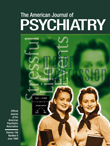To the Editor: Clozapine, the prototype of atypical antipsychotics, has been noted to have a number of unique clinical features, including the improvement of negative symptoms, when compared with conventional neuroleptics
(1). Subsequent studies with other novel neuroleptics also suggest clozapine’s superior efficacy in this particular respect
(2,
3).
Such claims are tempered by the argument that there is a distinction between primary, or deficit, and secondary negative symptoms
(4). Specifically, it is suggested that the former may reflect more enduring psychopathological changes and are therefore less amenable to change, whereas the latter relate to state phenomena such as depression, extrapyramidal symptoms, or environmental deprivation.
Path analysis and multiple regression have been employed as statistical procedures to establish whether changes in negative symptoms with treatment reflect shifts in primary versus secondary negative symptoms. These procedures are used on the basis of the premise that a direct effect on primary symptoms can be established by controlling for, or covarying out, improvement in secondary negative symptoms. By using these techniques, it has been suggested that clozapine
(5), risperidone
(6), and more recently, olanzapine
(7) each influence primary negative symptoms after the effects of the secondary negative symptoms are factored out.
There are several problems with such an approach. First, existing reports have not agreed on the identifiable secondary negative symptoms, with one study specifying only extrapyramidal and positive symptoms
(6), whereas others have addressed these as well as depressive symptoms
(5,
7). A second difficulty involves the possibility that other sources of secondary negative symptoms exist. For example, neurocognitive impairment is a common feature in schizophrenia and may be integrally related to negative symptoms
(8,
9). While there are reports suggesting that novel antipsychotics are superior to conventional neuroleptics with respect to cognitive measures
(10,
11), studies have not yet evaluated the potential impact that they could have on negative symptoms. Any investigation that omits variables that might contribute to secondary negative symptoms risks the possibility of erroneously attributing these changes to an influence on primary symptoms.
In light of these caveats, we must be cautious in evaluating claims that novel neuroleptics can improve true deficit symptoms. In fact, more recent work indicates that clozapine can influence secondary, but not primary, symptoms
(12). The optimal approach to evaluating change in true deficit symptoms is one that employs a valid measure prospectively. Statistical procedures may be of value but only if they ensure that all possible contributing factors to secondary negative symptoms are included in the analysis.

